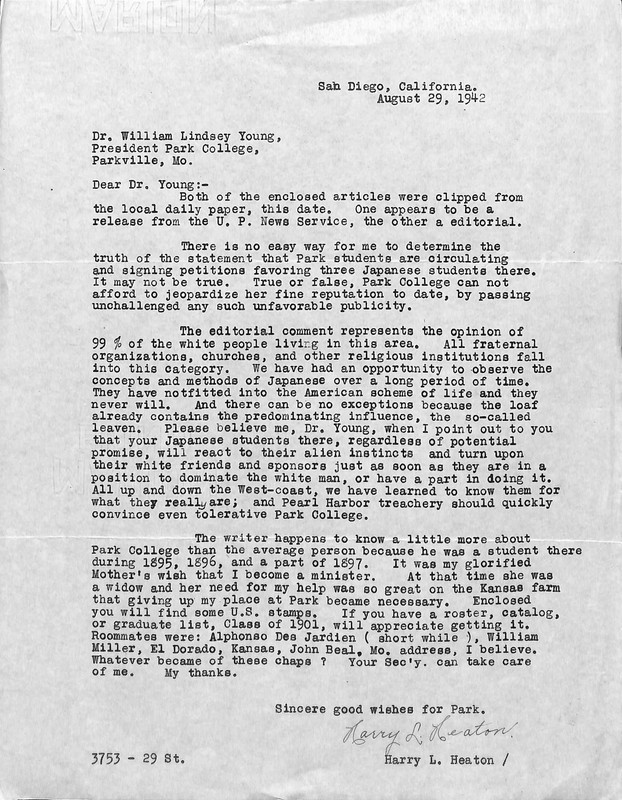Opposition based on the "Perpetual Foreigner" Concept - Harry L. Heaton
Introduction
Text-to-speech Audio
Dr. Young received approximately 500 letters of direct correspondence from those around the community, even those who had moved outside of Missouri throughout their life. While the vast majority of the letters displayed support, there were notable letters of opposition that reflected the thoughts of Mayor Dyer and Homer Mann. Opposition ranged in attitude, but oftentimes displayed hostility and instances of prejudice. Such opposition would lead to difficulties for Dr. Young and Park College in order to ensure the safety of Nisei students while also maintaining relations with the Parkville community.
Images
Heaton's letter condemning Japanese students, Aug. 29, 1942

Backstory and Context
Text-to-speech Audio
San Diego resident, Harry L. Heaton, an alumnus of Park College, addressed the admission of Nisei students in his letter, stating that:
"We have had an opportunity to observe the concepts and methods of Japanese over a long period of time. They have not fitted into the American scheme of life and they never will. And there can be no exceptions because the loaf already contains the predominating influence, the so-called leaven... Please believe me, Dr. Young, when I point out to you that your Japanese students there, regardless of potential promise, will react to their alien instincts and turn upon their white friends and sponsors just as soon as they are in a position to dominate the white man, or have a part in doing it" (Letter from Harry L. Heaton to Dr. Young, Aug. 29, 1942).
Heaton reflects long-held views of anti-Japanese sentiment that had permeated the United States. As early as the 1880s, anti-Japanese sentiments held that people with Japanese ancestry would never truly assimilate to American society and culture, developing a “perpetual foreigner” ideology (Daniels 116-117). Other naysayers voiced their opinion in similar ways, drawing upon similar thoughts that had been exacerbated by fear and hatred after Pearl Harbor.
Sources
Daniels, Roger. Asian America: Chinese and Japanese in the United States Since 1850. Seattle: University of Washington Press, 1988.
“Letter condemning Japanese students,” letter from Harry L. Heaton to Dr. William Lindsay Young, Aug. 29, 1942. Located in Francis Fishburn Archives and Special Collections, Park University Nisei Collection, Park University, Parkville, MO, ID: PC-L-1942.1.427.
“Letter condemning Japanese students,” letter from Harry L. Heaton to Dr. William Lindsay Young, Aug. 29, 1942, located in Francis Fishburn Archives and Special Collections, Park University Nisei Collection, Park University, Parkville, MO, ID: PC-L-1942.1.427. https://www.jstor.org/stable/community.32969322?searchText=PC-L-1942.1.427.&searchUri=%2Faction%2FdoBasicSearch%3FQuery%3DPC-L-1942.1.427.%26scope%3DeyJpZCI6ICIzMzI5MzMwNyIsICJwYWdlTmFtZSI6ICJQYXJrIFVuaXZlcnNpdHkgTmlzZWkgQ29sbGVjdGlvbiIsICJwYWdlVXJsIjogIi9zaXRlL3BhcmsvYXJjaGl2ZXMvcGFya3VuaXZlcnNpdHluaXNlaWNvbGxlY3Rpb24tMzMyOTMzMDcvIiwgInR5cGUiOiAiY29tcGlsYXRpb24iLCAicG9ydGFsTmFtZSI6ICJQYXJrIFVuaXZlcnNpdHkiLCAicG9ydGFsVXJsIjogIi9zaXRlL3BhcmsvIn0%253D&ab_segments=0%2Fbasic_search_gsv2%2Fcontrol&refreqid=fastly-default%3Aea0ccd24060851b4e36c2b6c78c7ff44&searchkey=1679622202957
